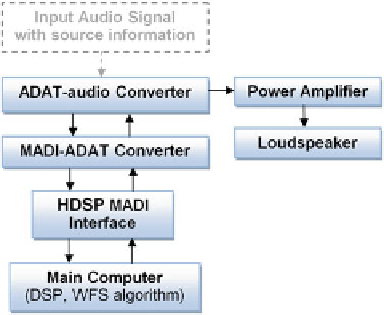Image Processing Reference
In-Depth Information
Fig. 11.3 An example of a loudspeaker array arrangement in a studio
Fig. 11.4 Block diagram
of main hardware including
DSP apparatus
converted data are sent to ADAT-MADI
2
converter. After all these conversions,
the resulting data are stored in a computer through MADI card and can be used for
digital signal processing (DSP). MADI helps to enable easier communication to the
WFS software installed in a computer without having to deal with raw audio data.
The data received in the computer is then incorporated into the WFS algorithm
together with the calibrated loudspeaker transfer functions and directivity to gen-
erate the desired sound signals. The data convolved with filter functions is saved as
phase-synchronous files which can be played back using any multi-channel com-
patible audio editor. In the system, after all the filtering process the signals are led to
the ADAT matrix which splits and transmits them to each channel. After being
played back by the computer, the separate audio signals are converted to MADI and
sent to the MADI-ADAT converter via RME
3
HDSP
4
sound cards with 64 outputs
each in MADI format and then ADAT-audio converter successively. The sound
generation system consists of loudspeaker arrays and power amplifiers. Each driver
2
MADI: Multi-Channel Audio Digital Interface.
3
RME Corporation.
4
Hammerfall DSP.


